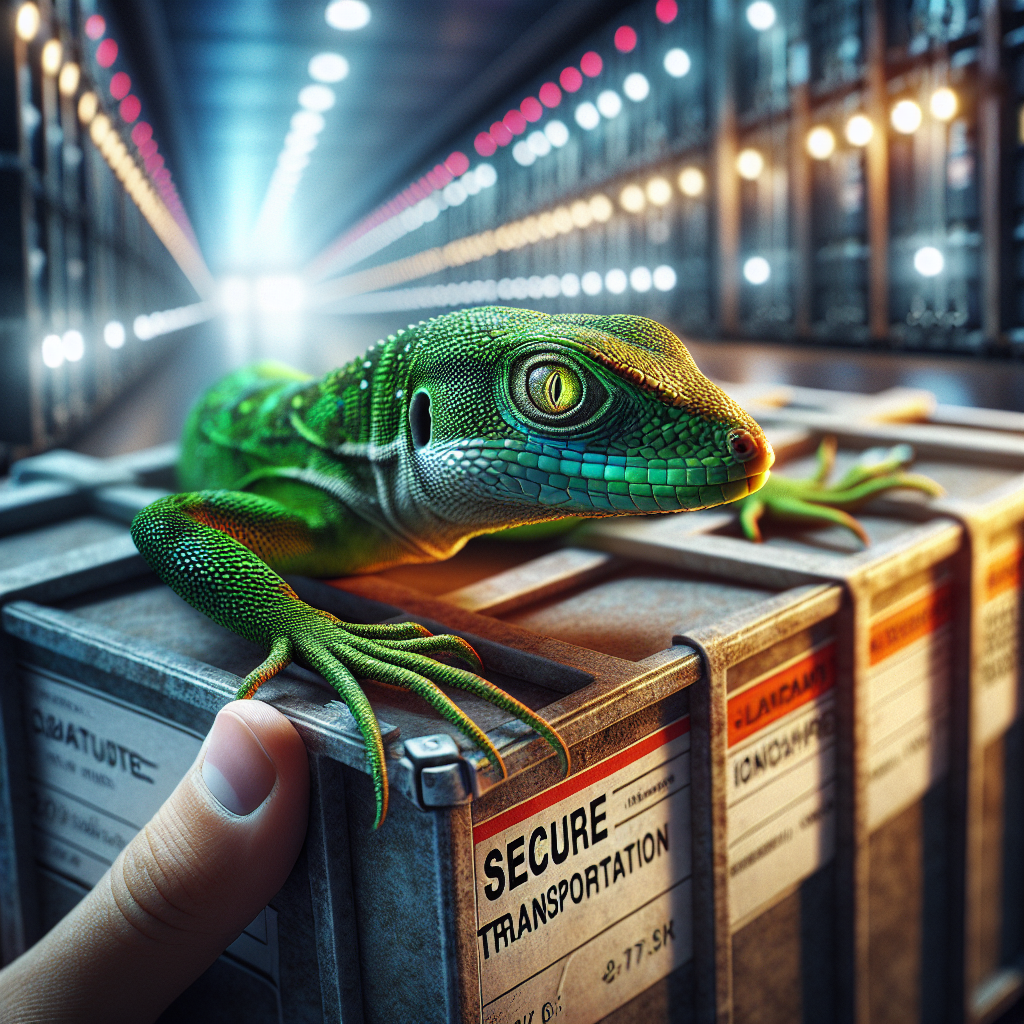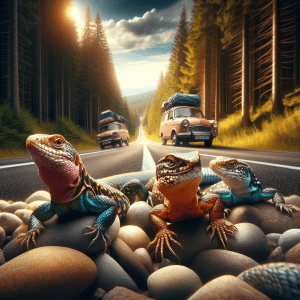Introduction: Importance of Safe Lizard Transportation
Transporting your beloved lizard can be a daunting task, but fear not – I’ve got you covered. As a seasoned expert in lizard care, I’ve seen it all when it comes to safe transportation. Picture this: you’re getting ready to move your scaly friend to a new location. It’s essential to understand your lizard’s unique needs. Did you know that lizards are highly sensitive to temperature changes during transportation? This means you need to ensure proper ventilation and temperature control. Choosing the right transport carrier is crucial – opt for a secure, well-ventilated container to keep your lizard safe. Now, let’s talk stress. Lizards can get anxious during travel, so it’s vital to minimize stress levels. What if an emergency arises during transportation? Have a plan in place to handle any unexpected situations. Long-distance travel with your lizard? I’ve got tips to make the journey smooth and comfortable. Once you’ve reached your destination, don’t forget post-transportation care and monitoring. Your lizard’s safety and well-being are my top priorities – let’s ensure they have a stress-free travel experience.
Understanding Your Lizard’s Needs
“Understanding Your Lizard’s Needs” is crucial when it comes to safe transportation. Picture this: you’re gearing up for a road trip with your scaly friend. But, do you know what your lizard needs for a smooth journey? Understanding your lizard’s specific requirements is key. From temperature preferences to space necessities, each lizard has unique needs that must be met during transportation. It’s like tailoring a trip to suit your lizard’s comfort levels. So, how can you ensure you’re meeting those needs? By diving deep into the world of lizard behavior and biology. Think about it: would you pack the same way for a tropical gecko as you would for a desert-dwelling beardie? Nope! That’s why understanding your lizard’s needs is the first step to a successful transport adventure. With this knowledge in hand, you can create a stress-free environment that caters to your lizard’s well-being. Ready to embark on a journey filled with tail flicks and tiny toe taps? Understanding your lizard’s needs is your ticket to a safe and happy travel experience.
Preparing for Transportation: Checklist
Alright, let’s dive into the nitty-gritty of preparing your lizard for transportation. Picture this: you’re gearing up for a road trip, but instead of packing your own bags, you’re getting your scaly friend ready for the journey. It’s important to create a checklist to ensure everything goes smoothly. First up, make sure your lizard’s enclosure is secure and escape-proof. You don’t want any unexpected escape artists on your hands while on the move. Next, provide ample food and water before the trip to keep your lizard comfortable and hydrated. Remember, a well-fed lizard is a happy lizard during travel. Double-check the temperature and lighting in the transport carrier to mimic their natural habitat. Lizards are sensitive to temperature changes, so maintaining a consistent environment is key. Finally, minimize stress by keeping noise levels low and avoiding sudden movements. Your lizard will thank you for the calm and peaceful journey. By following these tips, you’ll ensure your lizard travels in comfort and safety, making the journey a breeze for both of you.
Choosing the Right Transport Carrier
When it comes to transporting your lizards, choosing the right carrier is absolutely crucial. You wouldn’t want your scaly friends to be uncomfortable or unsafe during the journey, right?
One practical tip that I always swear by is to opt for a carrier that is well-ventilated. Lizards need fresh air to stay healthy, just like us! Plus, good ventilation helps regulate the temperature inside the carrier, ensuring your little buddies stay cozy.
Imagine this: you’re on a road trip with your lizards, and they’re happily basking in the warmth of a well-ventilated carrier. It’s like a mini-vacation for them, don’t you think?
Not only does proper ventilation keep your lizards happy, but it also reduces the risk of stress-related health issues. Remember, a happy lizard is a healthy lizard!
So, the next time you plan a lizard adventure, make sure to choose a carrier with excellent ventilation. Your scaly companions will thank you with their little lizard smiles (if lizards could smile, that is).
Ensuring Proper Ventilation and Temperature Control
Transporting your lizard is no joke; it’s a serious matter that requires careful planning and execution. Picture this: you’re gearing up for a road trip with your scaly friend, and you want to make sure they’re as comfy as can be. The key to a successful lizard journey lies in the carrier you choose. Opt for a well-ventilated container that allows your pet to breathe easy. And here’s a fun fact for you: did you know that lizards are highly sensitive to temperature changes? That’s right! So, maintaining a stable and cozy temperature during the trip is crucial for their well-being. Now, let’s talk about stress. Yes, even lizards can get stressed out during travel. To keep their anxiety levels low, try to minimize sudden movements and loud noises. Think of it as a spa day for your scaly buddy! So, what’s the takeaway here? By following these simple tips, you can ensure a smooth and safe journey for your beloved lizard companion. Just imagine the look of contentment on their little face as they bask in the warmth of your careful planning. Happy travels, lizard lovers!
Minimizing Stress During Transportation
Imagine you’re gearing up for a road trip with your lizard. You’ve got the carrier ready, the snacks packed, and the playlist sorted. But what about the lizard’s comfort during the journey? That’s where minimizing stress during transportation comes into play.
Picture this: You’re cruising down the highway, and your lizard is basking in the warmth of the sunlamp you’ve set up in the carrier. It’s a scene straight out of a reptile relaxation manual. But how do you ensure this idyllic scenario stays stress-free?
Let’s dive into some practical tips to keep your lizard cool as a cucumber during travel. First up, make sure the carrier is secure and cozy, with plenty of space for your scaly friend to move around. A stressed lizard is not a happy lizard, trust me on this.
Now, let’s talk about the importance of maintaining a consistent temperature inside the carrier. Lizards are cold-blooded creatures, so fluctuations in temperature can really throw them off. Invest in a good heat source for the carrier to keep them toasty.
And here’s a fun fact for you: did you know that some lizards can change color based on their mood or environment? Imagine your lizard turning into a little rainbow chameleon as you drive through different landscapes!
So, as you gear up for your lizard’s next adventure, remember these tips to minimize stress and keep your scaly companion calm and content throughout the journey. Happy travels, both to you and your lizard buddy!
Handling Emergencies and Contingencies
Ever found yourself in a sticky situation while transporting your lizard friend? Handling emergencies and contingencies during lizard travel can be nerve-wracking, but fear not, I’ve got your back. Picture this: you’re on a road trip with your lizard companion, enjoying the scenic views, when suddenly, disaster strikes. Maybe the carrier tips over, or your lizard seems distressed – what do you do? First things first, stay calm. Your lizard can sense your emotions, so keeping a cool head is crucial. Assess the situation quickly but carefully. Is your lizard injured? Is the carrier damaged? Once you’ve made a quick evaluation, it’s time to act. Have a lizard first aid kit handy with essentials like sterile gauze, antiseptic wipes, and tweezers. Knowing basic lizard first aid can make all the difference in emergencies. Remember, prevention is key too. Secure the carrier properly, maintain a comfortable temperature, and avoid sudden movements to minimize risks. Share your experience with friends or fellow lizard owners – you never know when your knowledge could save the day. So, stay prepared, stay vigilant, and most importantly, stay calm in the face of unexpected challenges. Your lizard will thank you for it!
Tips for Long-Distance Lizard Travel
Alright, let’s dive into the nitty-gritty of long-distance lizard travel. Picture this: you’re gearing up for a road trip with your scaly companion. You’ve got everything packed – food, water, and a cozy habitat. But wait, there’s more to consider when embarking on a journey with your lizard buddy.
When hitting the road for an extended trip, it’s crucial to ensure your lizard’s comfort and safety throughout the journey. Think of it as planning a vacation for your tiny reptilian friend. Now, here’s a fascinating fact: did you know that lizards are highly sensitive to temperature changes? That’s right – maintaining the right temperature in their carrier is key to a stress-free travel experience.
So, how can you make sure your lizard stays chill during a long ride? One practical tip is to use a portable heating pad or a cooling pack, depending on the lizard’s temperature preferences. Keeping a close eye on the temperature inside the carrier will help your lizard feel at ease during the trip.
But here’s the kicker – what if your lizard starts showing signs of distress during the journey? Stay calm and address the situation promptly. Offer a gentle reassurance and check if any adjustments need to be made to the carrier’s environment. Remember, your lizard’s well-being is the top priority.
As you gear up for your next lizard travel adventure, keep these tips in mind to ensure a smooth and safe journey for your scaly sidekick. Happy travels!
Post-Transportation Care and Monitoring
Have you ever wondered how your lizard feels after a long journey? Post-transportation care and monitoring are crucial to ensure your scaly friend settles back into its routine smoothly. It’s like when you return home from a vacation – you need time to readjust, right? Your lizard is no different. Keep an eye on its behavior, appetite, and energy levels. Sometimes, a little extra TLC goes a long way in comforting your pet. Consider creating a cozy, stress-free environment to help your lizard relax after the trip. Offer its favorite treats and toys to make it feel at home again. Remember, your lizard’s well-being is top priority, so monitor any signs of distress or illness closely. Think of it as a welcome-back party for your reptilian companion – show them some love and care. By being attentive and responsive, you can ensure a smooth transition back to normalcy for your beloved lizard. After all, a happy lizard makes for a happy lizard parent!
Conclusion: Happy Lizards, Safe Travels
When it comes to safe lizard transportation, there’s a whole lot more to it than meets the eye. Picture this: you’re getting ready to move your scaly buddy to a new location. You want to make sure they’re comfortable and stress-free throughout the journey, right? Well, that’s where my expertise comes into play.
Let’s dive into the nitty-gritty details of ensuring your lizard’s safety during transportation. Did you know that lizards are sensitive creatures that require specific conditions to thrive? Understanding your lizard’s needs is key to a successful journey. From preparing the right transport carrier to maintaining optimal ventilation and temperature control, every step counts.
Now, let’s talk about stress. Just like us, lizards can feel anxious during travel. So, how do you minimize their stress levels? Stay tuned for some handy tips and tricks. And hey, emergencies happen. It’s essential to be prepared for any unexpected situations that may arise during transportation.
Ever wondered how to make long-distance lizard travel a breeze? I’ve got you covered with expert advice. And after the journey is over, don’t forget about post-transportation care and monitoring. Your lizard’s well-being doesn’t stop when the wheels stop rolling.
So, buckle up and get ready for a wild ride through the world of safe lizard transportation. Your scaly friend will thank you for it!




